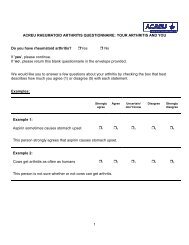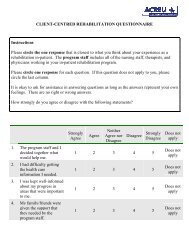Client-Centred Rehabilitation - Arthritis Community Research ...
Client-Centred Rehabilitation - Arthritis Community Research ...
Client-Centred Rehabilitation - Arthritis Community Research ...
Create successful ePaper yourself
Turn your PDF publications into a flip-book with our unique Google optimized e-Paper software.
A national survey of acute care hospitals<br />
was conducted using the instrument they had<br />
developed based on what the patients<br />
themselves really cared about. Field visits to<br />
organizations were also conducted to<br />
understand the culture of organizations that<br />
did well in the surveys or poorly. A number<br />
of findings from the early work of Picker<br />
were published in the book “Through the<br />
Eye’s of the Patient” (Gerteis and Roberts,<br />
1993).<br />
The focus of Picker in the last ten years has<br />
been to assist organizations in obtaining<br />
information from patients about their needs<br />
and concerns. The community has not been<br />
easy to convince that issues from the patient<br />
perspective need to be addressed. Clinicians<br />
and administrators went through a phase of<br />
denial and resistance to patient-centredness<br />
(Delbanco, 1995). Patients do have valid<br />
concerns and it is important to incorporate<br />
these as in future healthcare designs. Many<br />
factors are influencing the push toward<br />
client centred care including: a rise in<br />
patient expectations, changing culture,<br />
availability of information (Internet), and the<br />
feminist movement.<br />
The Picker Institute continues their<br />
fieldwork to examine how far organizations<br />
are in their work with patient-centred<br />
initiatives. They have found that<br />
organizations call it different things, and<br />
implement different strategies but an effort<br />
is consciously being made to improve the<br />
patient experience.<br />
Picker also provides patient-centred<br />
resources for improving the healthcare<br />
experience for patients through The New<br />
Visions: Ideas Worth Sharing Bulletin. This<br />
bulletin was initiated to provide<br />
opportunities for communication amongst<br />
various groups with respect to patientcentred<br />
work. The bulletin is distributed<br />
18<br />
via email and hard copy. Bulletins can be<br />
viewed on their web page (www.picker.org).<br />
2.5 Measuring <strong>Client</strong>-centred<br />
<strong>Rehabilitation</strong>: <strong>Client</strong>-centred<br />
Tools<br />
There is no single, well established tool for<br />
measuring client-centred rehabilitation,<br />
however, there are a number of tools that<br />
have been developed that are potentially<br />
useful. In this section we review various<br />
measures that can be used to measure clientcentred<br />
care in rehabilitation. Appendices<br />
A-D contain more detailed information<br />
about each measure. Although all of the<br />
organizations were very generous in sharing<br />
their research tools with us, for copyright<br />
reasons we are unable to reproduce the<br />
actual tools in this report.<br />
2.5.1 Canadian Occupational<br />
Performance Measure<br />
Acting upon recommendations in the third<br />
guidelines document AToward Outcome<br />
Measures in Occupational Therapy@<br />
(DNHW and CAOT, 1987), the National<br />
Health <strong>Research</strong> and Development Program<br />
(NHRDP) and the Canadian Occupational<br />
Therapy Foundation (COTF) funded a<br />
research team which developed the<br />
Canadian Occupational Performance<br />
Measure (COPM). The purpose of the<br />
COPM is Ato enable occupational therapy<br />
clients to participate in a meaningful way in<br />
determining the course of occupational<br />
therapy intervention@ (p. 192, Law et al.,<br />
1994). The COPM is an individual,<br />
standardized measure administered to a<br />
client or to a proxy respondent such as<br />
family, caregiver or teacher in a semistructured<br />
interview. The COPM may be<br />
employed with clients throughout their life<br />
span (from >cradle to grave=) and is








